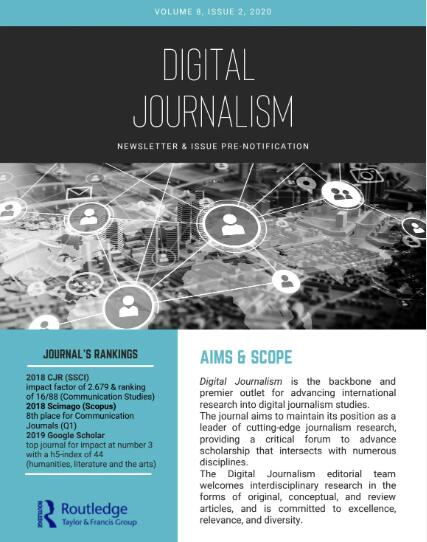在个性化算法中考虑个性化:YouTube对阴谋内容的处理
IF 5.2
1区 文学
Q1 COMMUNICATION
引用次数: 0
摘要
本文调查了在何种视频观看条件下,YouTube的推荐系统倾向于对阴谋分类视频产生偏好。现有的关于所谓的过滤气泡和兔子洞的研究往往依赖于非个性化的推荐和标准的手表模式,而这项研究将个性化和多样化的用户策略置于其设计的中心。20个经过认证的机器人被指示根据四种不同的观看策略观看YouTube内容。在基线策略中,机器人只观看非阴谋视频。治疗策略包括观看阴谋分类的内容,根据非个性化、部分个性化或完全个性化的输入进行选择。机器人总共观看了15个视频,在每个视频之后,它们的前20个主页推荐被收集起来,并被分类为与阴谋有关或无关。这使我们能够衡量每个观看视频和每个观看策略对每个步骤推荐的阴谋分类内容比例的影响。同样的实验被重新进行,只让实验组观看非阴谋视频,以评估这种模式的持久性。我们的研究结果表明,被阴谋分类内容启动的用户倾向于迅速获得更大比例的阴谋分类推荐。事实证明,反转这个模式比生成它要困难得多。也有迹象表明,依赖个性化内容作为输入的观看策略可能会产生更强的效果。这篇文章为YouTube的推荐系统容易产生强大的、潜在有害的推荐模式的论点提供了证据。此外,它还提供了一种可复制的方法,将个性化置于内容个性化算法研究的中心位置。本文章由计算机程序翻译,如有差异,请以英文原文为准。
Accounting for Personalization in Personalization Algorithms: YouTube’s Treatment of Conspiracy Content
This article investigates under which video watch conditions YouTube’s recommender system tends to develop a preference for conspiracy-classified videos. Whereas existing research on so-called filter bubbles and rabbit holes tends to rely on non-personalized recommendations and on standard watch patterns, this study puts personalization and diversified user strategies at the center of its design. 20 authenticated bots have been instructed to watch YouTube content based on four distinct watch strategies. In a baseline strategy, bots watched non-conspiracy videos only. Treatment strategies involved watching conspiracy-classified content, selected based on either non-personalized, partly-personalized, or fully-personalized input. Bots watched a total of 15 videos, and after each video their top 20 homepage recommendations were collected and classified as either conspiracy-related or not. This allowed us to measure the impact of each video watched and of each watch strategy on the proportion of conspiracy-classified content recommended at each step. The same experiment has been reverted, exposing the treatment groups to non-conspiracy videos only, to assess the persistence of this pattern. Our results show that users primed with conspiracy-classified content tend to quickly receive a much larger proportion of conspiracy-classified recommendations. Inverting this pattern proves significantly more difficult than generating it. There are also indications that watch strategies relying on personalized content as input might produce stronger effects. This article contributes evidence to the argument that YouTube’s recommendation system is prone to generating strong, potentially pernicious recommendation patterns. Moreover, it contributes a replicable methodology that puts personalization at the center of the stage in the study of content personalization algorithms.
求助全文
通过发布文献求助,成功后即可免费获取论文全文。
去求助
来源期刊

Digital Journalism
COMMUNICATION-
CiteScore
11.20
自引率
24.10%
发文量
103
期刊介绍:
Digital Journalism provides a critical forum for scholarly discussion, analysis and responses to the wide ranging implications of digital technologies, along with economic, political and cultural developments, for the practice and study of journalism. Radical shifts in journalism are changing every aspect of the production, content and reception of news; and at a dramatic pace which has transformed ‘new media’ into ‘legacy media’ in barely a decade. These crucial changes challenge traditional assumptions in journalism practice, scholarship and education, make definitional boundaries fluid and require reassessment of even the most fundamental questions such as "What is journalism?" and "Who is a journalist?" Digital Journalism pursues a significant and exciting editorial agenda including: Digital media and the future of journalism; Social media as sources and drivers of news; The changing ‘places’ and ‘spaces’ of news production and consumption in the context of digital media; News on the move and mobile telephony; The personalisation of news; Business models for funding digital journalism in the digital economy; Developments in data journalism and data visualisation; New research methods to analyse and explore digital journalism; Hyperlocalism and new understandings of community journalism; Changing relationships between journalists, sources and audiences; Citizen and participatory journalism; Machine written news and the automation of journalism; The history and evolution of online journalism; Changing journalism ethics in a digital setting; New challenges and directions for journalism education and training; Digital journalism, protest and democracy; Journalists’ changing role perceptions; Wikileaks and novel forms of investigative journalism.
 求助内容:
求助内容: 应助结果提醒方式:
应助结果提醒方式:


